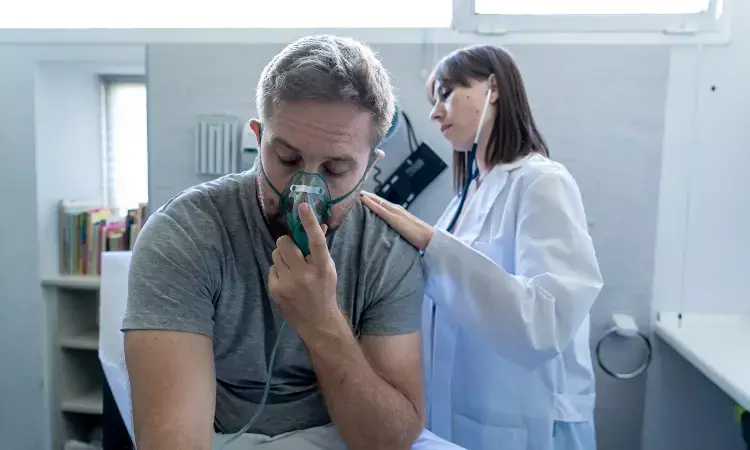- Home
- Medical news & Guidelines
- Anesthesiology
- Cardiology and CTVS
- Critical Care
- Dentistry
- Dermatology
- Diabetes and Endocrinology
- ENT
- Gastroenterology
- Medicine
- Nephrology
- Neurology
- Obstretics-Gynaecology
- Oncology
- Ophthalmology
- Orthopaedics
- Pediatrics-Neonatology
- Psychiatry
- Pulmonology
- Radiology
- Surgery
- Urology
- Laboratory Medicine
- Diet
- Nursing
- Paramedical
- Physiotherapy
- Health news
- Fact Check
- Bone Health Fact Check
- Brain Health Fact Check
- Cancer Related Fact Check
- Child Care Fact Check
- Dental and oral health fact check
- Diabetes and metabolic health fact check
- Diet and Nutrition Fact Check
- Eye and ENT Care Fact Check
- Fitness fact check
- Gut health fact check
- Heart health fact check
- Kidney health fact check
- Medical education fact check
- Men's health fact check
- Respiratory fact check
- Skin and hair care fact check
- Vaccine and Immunization fact check
- Women's health fact check
- AYUSH
- State News
- Andaman and Nicobar Islands
- Andhra Pradesh
- Arunachal Pradesh
- Assam
- Bihar
- Chandigarh
- Chattisgarh
- Dadra and Nagar Haveli
- Daman and Diu
- Delhi
- Goa
- Gujarat
- Haryana
- Himachal Pradesh
- Jammu & Kashmir
- Jharkhand
- Karnataka
- Kerala
- Ladakh
- Lakshadweep
- Madhya Pradesh
- Maharashtra
- Manipur
- Meghalaya
- Mizoram
- Nagaland
- Odisha
- Puducherry
- Punjab
- Rajasthan
- Sikkim
- Tamil Nadu
- Telangana
- Tripura
- Uttar Pradesh
- Uttrakhand
- West Bengal
- Medical Education
- Industry
Clarithromycin bests erythromycin against community-acquired pneumonia

Saudi Arabia: In adults and adolescents, erythromycin is less effective than clarithromycin as empiric therapy for community-acquired pneumonia (CAP), says a new article published in the Journal of Infection and Chemotherapy.
It is controversial whether erythromycin is as effective as other macrolides in the treatment of community-acquired pneumonia. As a result, Noha Ashy and colleagues undertook this study to evaluate the effectiveness of erythromycin with clarithromycin and azithromycin.
For this experiment, a meta-analysis of randomized controlled trials (RCTs) of adults or adolescents with CAP comparing the effectiveness of erythromycin monotherapy to either azithromycin or clarithromycin was done. To acquire relevant data, the PubMed, EMBASE, and Cochrane Library databases, as well as three clinical trial registries, were searched up to November 02, 2021. Risk ratios with 95 percent confidence intervals were calculated using heterogeneity and random-effects models.
The key findings of this study were as follows:
1. Four randomized controlled trials (RCTs) with a total of 472 patients were included to examine the therapeutic effectiveness of erythromycin vs clarithromycin.
2. There were no studies that compared erythromycin monotherapy to azithromycin monotherapy.
3. When compared to clarithromycin, erythromycin was linked with considerably reduced rates of clinical success, clinical cure, and radiological success.
4. The researchers stated that erythromycin should be explored when clarithromycin and azithromycin are in low supply or when erythromycin may be more economical to the patient.
5. They reasoned that clarithromycin's improved effectiveness was due to a longer half-life, greater plasma concentration, and increased action against a broader range of CAP pathogens such as H influenzae.
In conclusion, because erythromycin is less effective and has a high discontinuation rate due to gastrointestinal side effects, it should not be chosen for the treatment of CAP unless other macrolides cannot be used and clinical practice guidelines must be followed. state this clearly.
Reference:
Ashy, N., Alharbi, L., Alkhamisi, R., Alradadi, R., & Eljaaly, K. (2022). Efficacy of erythromycin compared to clarithromycin and azithromycin in adults or adolescents with community-acquired pneumonia: A Systematic Review and meta-analysis of randomized controlled trials. In Journal of Infection and Chemotherapy (Vol. 28, Issue 8, pp. 1148–1152). Elsevier BV. https://doi.org/10.1016/j.jiac.2022.04.020
Neuroscience Masters graduate
Jacinthlyn Sylvia, a Neuroscience Master's graduate from Chennai has worked extensively in deciphering the neurobiology of cognition and motor control in aging. She also has spread-out exposure to Neurosurgery from her Bachelor’s. She is currently involved in active Neuro-Oncology research. She is an upcoming neuroscientist with a fiery passion for writing. Her news cover at Medical Dialogues feature recent discoveries and updates from the healthcare and biomedical research fields. She can be reached at editorial@medicaldialogues.in
Dr Kamal Kant Kohli-MBBS, DTCD- a chest specialist with more than 30 years of practice and a flair for writing clinical articles, Dr Kamal Kant Kohli joined Medical Dialogues as a Chief Editor of Medical News. Besides writing articles, as an editor, he proofreads and verifies all the medical content published on Medical Dialogues including those coming from journals, studies,medical conferences,guidelines etc. Email: drkohli@medicaldialogues.in. Contact no. 011-43720751


